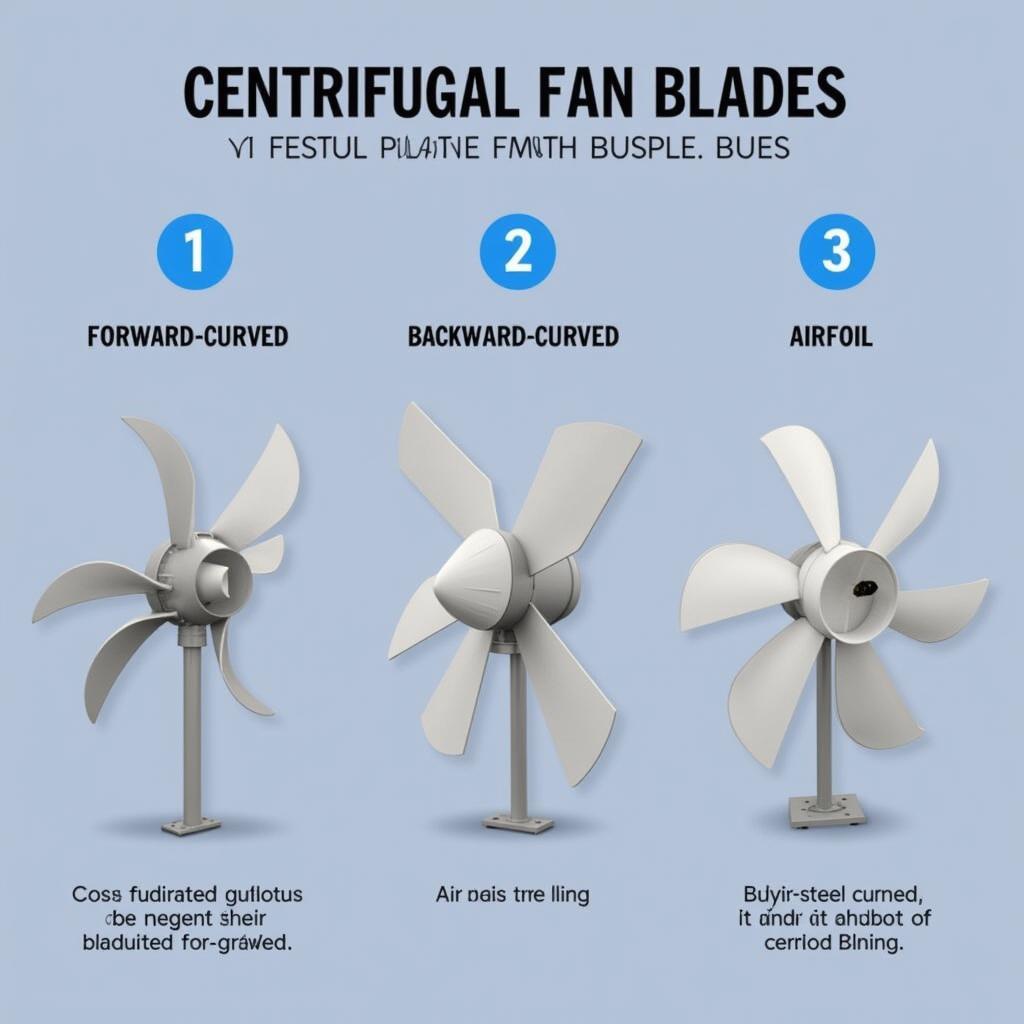Centrifugal fans are essential components in various industrial and commercial applications, from ventilation systems to industrial processes. Understanding the impact of the blade angle of a centrifugal fan is crucial for optimizing its efficiency and achieving desired airflow characteristics.
 Types of Centrifugal Fan Blades
Types of Centrifugal Fan Blades
The blade angle, also known as the blade inclination or blade setting, significantly influences the fan’s pressure capabilities, airflow rate, and power consumption. Let’s delve into how this critical design element impacts centrifugal fan performance.
How Blade Angle Affects Centrifugal Fan Operation
The angle at which the blades are set within the impeller determines how the air interacts with the fan. This interaction directly influences the fan’s ability to generate pressure and move air.
-
Forward-Curved Blades: These blades, with their tips curving in the direction of the impeller’s rotation, are known for moving large volumes of air at relatively low pressures. This characteristic makes them suitable for applications like HVAC systems and drying processes. However, due to their design, they are more prone to overloading and require careful motor selection to prevent damage.
-
Backward-Curved Blades: In contrast to forward-curved blades, backward-curved blades have tips curving opposite the direction of the impeller’s rotation. This design allows for higher pressure generation with lower noise levels and increased efficiency. They are often found in industrial settings requiring higher pressure, such as dust collection systems and material handling.
-
Airfoil Blades: Representing a more specialized design, airfoil blades prioritize efficiency and quiet operation. Their aerodynamic shape minimizes turbulence and energy loss, making them ideal for noise-sensitive environments and applications demanding high efficiency, like cleanroom ventilation and cooling systems.
 Impact of Blade Angle on Airflow
Impact of Blade Angle on Airflow
Choosing the Right Blade Angle for Your Application
Selecting the appropriate blade angle is paramount to achieving optimal fan performance. Factors to consider include:
- Required Airflow Rate: Applications demanding high air volume at lower pressures benefit from forward-curved blades.
- System Pressure Requirements: Backward-curved or airfoil blades are more suitable for systems requiring higher static pressures.
- Efficiency Needs: When energy efficiency is a priority, airfoil blades or backward-curved blades with higher efficiencies are often preferred.
- Noise Sensitivity: Airfoil blades and backward-curved blades generally offer quieter operation compared to forward-curved designs.
Blade Angle Adjustments and Optimization
While the initial blade angle is set during manufacturing, some fans offer the capability for adjustments. This flexibility allows for fine-tuning fan performance in the field to match specific operating conditions or compensate for system changes.
 Adjusting Centrifugal Fan Blade Angle
Adjusting Centrifugal Fan Blade Angle
Regular inspection and maintenance are crucial to ensure optimal blade angle and overall fan performance. Over time, factors like dust accumulation, blade erosion, and bearing wear can affect fan efficiency and airflow.
Conclusion
The blade angle of a centrifugal fan plays a pivotal role in determining its airflow characteristics, pressure capabilities, and overall efficiency. Understanding the differences between forward-curved, backward-curved, and airfoil blades is essential for selecting the right fan for a specific application. By carefully considering the factors influencing blade angle selection and prioritizing regular maintenance, you can optimize centrifugal fan performance and ensure long-term, reliable operation.
If you’re unsure about choosing the right blade angle for your needs, consult with a fan expert or refer to our grand exhause fan model catalue. We can help you find the perfect fan solution to meet your specific requirements.


